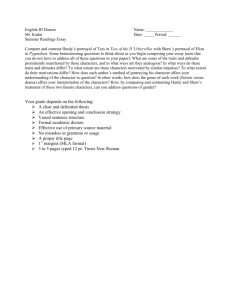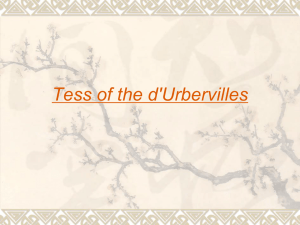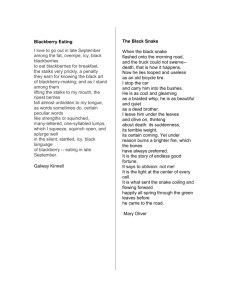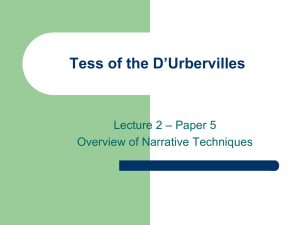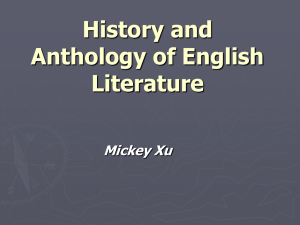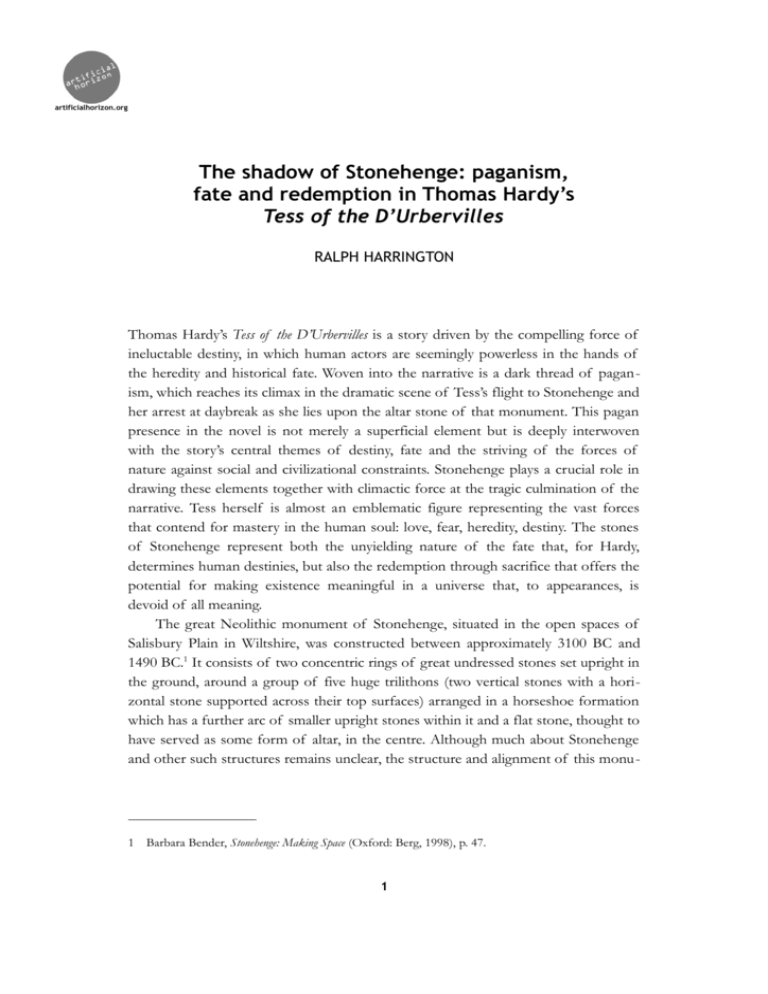
artificialhorizon.org
The shadow of Stonehenge: paganism,
fate and redemption in Thomas Hardy’s
Tess of the D’Urbervilles
RALPH HARRINGTON
Thomas Hardy’s Tess of the D’Urbervilles is a story driven by the compelling force of
ineluctable destiny, in which human actors are seemingly powerless in the hands of
the heredity and historical fate. Woven into the narrative is a dark thread of paganism, which reaches its climax in the dramatic scene of Tess’s flight to Stonehenge and
her arrest at daybreak as she lies upon the altar stone of that monument. This pagan
presence in the novel is not merely a superficial element but is deeply interwoven
with the story’s central themes of destiny, fate and the striving of the forces of
nature against social and civilizational constraints. Stonehenge plays a crucial role in
drawing these elements together with climactic force at the tragic culmination of the
narrative. Tess herself is almost an emblematic figure representing the vast forces
that contend for mastery in the human soul: love, fear, heredity, destiny. The stones
of Stonehenge represent both the unyielding nature of the fate that, for Hardy,
determines human destinies, but also the redemption through sacrifice that offers the
potential for making existence meaningful in a universe that, to appearances, is
devoid of all meaning.
The great Neolithic monument of Stonehenge, situated in the open spaces of
Salisbury Plain in Wiltshire, was constructed between approximately 3100 BC and
1490 BC.1 It consists of two concentric rings of great undressed stones set upright in
the ground, around a group of five huge trilithons (two vertical stones with a horizontal stone supported across their top surfaces) arranged in a horseshoe formation
which has a further arc of smaller upright stones within it and a flat stone, thought to
have served as some form of altar, in the centre. Although much about Stonehenge
and other such structures remains unclear, the structure and alignment of this monu-
1 Barbara Bender, Stonehenge: Making Space (Oxford: Berg, 1998), p. 47.
1
RALPH HARRINGTON · The shadow of Stonehenge
RALPH HARRINGTON · ‘So jarred were all my nerves’
ment indicate that its function was ritual, possibly associated with the worship of the
sun and the marking of significant moments in the annual cycle of nature: 2
There is a sufficient body of evidence to suggest strongly that
astronomical observation was one, if not the most important,
function of many stone circles … Observations … were probably
integral to the planning of seasonal festivals. Down to medieval
times, festivals were held in spring and at midsummer and, in
north-west Europe, at Hallowe’en (the Celtic Samain) and May
Day (the Celtic Beltane).3
Stonehenge, like other ancient monuments of Wessex such as hill forts and
castles, features several times in the writings of Thomas Hardy, both prose and
poetry. Hardy was fascinated by archaeology and by the societies and cultures of past
ages, particularly by their religious and mystical aspects. In The Return of the Native
(1878) for example, he suggests that the custom of celebrating Bonfire Night on 5
November each year with huge bonfires on the crests of Wessex hills is of ‘druidic’
and ‘Saxon’ origin rather than relating to the Gunpowder Plot of the seventeenth
century.4 Elsewhere, notably in Under the Greenwood Tree (1872) and The Mayor of Casterbridge (1886), he makes great play with rituals that have survived from the remote
past into the life of the Wessex of his own age. Stonehenge, situated in the heart of
Hardy’s Wessex, constituted a very potent source of symbolism for him, as well as
providing a setting of unique drama and resonance for the climactic scene of Tess of
the D’Urbervilles. In the late nineteenth century Stonehenge was little understood even
in academic and antiquarian circles, being connected variously with Merlin and King
Arthur, Ancient Egyptians, wandering Trojan warriors, the Danes and the Romans.5
The meanings the monument possessed and the narratives woven around it can be
said to have constituted it as a place of memory, a location where the collective
memory of a community (both the particular communities about which Hardy is
writing and the wider community of those who read his works) could be created and
re-created and upon which cultural ideas and structures of meaning could be projected. Hardy evokes and engages with this many-faceted significance, using Stonehenge
2 Bender, Stonehenge, p. 53.
3 Lloyd Laing and Jennifer Laing, The Origins of Britain (London: Routledge, 1980), pp. 206-7.
4 Herbert B. Grimsditch, Character and Environment in the Novels of Thomas Hardy (New York: Russell
& Russell, 1962), p. 86.
5 Laing and Laing, Origins of Britain, pp. 200-1.
2
RALPH HARRINGTON
· The shadow of Stonehenge
as a symbol of great power around which he can weave the life, character and fate of
his heroine, and give expression to his conception of her place in the wider universal
order of existence.
Fundamentally, Stonehenge for Hardy stands for ‘the natural’, and – as Hardy
himself makes clear – Tess Durbeyfield, described in the subtitle of Tess as ‘a pure
woman’, is pure in the sense of being ‘natural’, in her femininity, her beauty, and her
motivations.6 It is therefore fitting that it is at Stonehenge that the climax of the
story, the arrest of Tess, takes place, but this significance is prefigured in the early
part of the book with the description in chapter II of the ritual of ‘Club-walking
Day’, a pagan festival celebrating spring and fertility, in which Tess takes part. The
story can thus be said to begin with the moving circle of girls and women in white
(among them is Tess, marked out by her red ribbon) performing a pagan ritual; it
ends with the immobile circle of grey stones, a heathen temple of nature. The rough
primitiveness of both these circles, echoing each other across the length of the
narrative, expresses the central role that primal, instinctive drives take in this highly
sensual and tragic story, and embodies one of the oppositional pairings that Hardy
used as a fundamental structure of the novel: that between ‘nature’ and ‘society’.
The Club-walking dance is the first in a series of events and places with pagan
associations which occupy crucial positions in the unfolding narrative of Tess, focusing and expressing the themes of paganism and the forces of nature which underlie
the story. Thus the seduction of Tess by Alec D’Urberville takes place in the ancient
woodland, The Chase, that surrounds D’Urberville’s estate. In his evocation of The
Chase, Hardy emphasizes the power of the forces of nature to be found there and
the primeval energies that surround Alec and Tess as, in an act redolent both of
transgression and regression, they penetrate the wood:
Darkness and silence ruled everywhere around. Above them rose
the primeval yews and oaks of The Chase, in which there poised
gentle roosting birds in their last nap; and about them stole the
hopping rabbits and hares.7
A repeated strategy used by Hardy is to emphasize the oneness of Tess with nature
and at the same time to relate that supposed ‘natural’ quality directly to her gender –
to the fact that she is female. At times he seems almost to absorb Tess into the nat-
6 T. R. Wright, Hardy and the Erotic (Basingstoke: Macmillan, 1989), p. 106.
7 Thomas Hardy, Tess of the D’Urbervilles (1891; London: Penguin, 1998), ch. XI, p. 74.
3
RALPH HARRINGTON
· The shadow of Stonehenge
ural world, breaking down the barriers between her and the realm of animals, plants,
the earth, the primordial forces of creation and destruction. When Tess goes into the
fields to work at the harvest after giving birth to Alec’s child, she is described in a
way that makes an explicit link between womanhood, fertility, the earth and the
cycles of nature. Whereas the male workers in the fields are separate from the earth
upon which they toil, Tess, a woman, is a part of it: a ‘field-man’, writes Hardy, ‘is a
personality afield; a field-woman is a portion of the field; she had somehow lost her
own margin, imbibed the presence of her surrounding, and assimilated herself with
it’.8 There is also a clear evocation of Tess’s inability to escape from fate and to act as
an individual possessing free will: the men at work in the fields are personalities who
are in the field, but Tess is ‘a portion of the field’ with no ‘margin’ separating her
from it. She is linked by indissoluble bonds to the earth, as she is to the fate decreed
for her by the forces of fate, heredity and nature. This point is emphasized by Tess’s
own response to her situation and Hardy’s authorial treatment of that response,
which is to deny Tess any social or moral agency of her own and present her as
entirely the tool of the laws of nature. After falling prey to Alec’s desires, Tess feels
guilt and shame, and sees herself as a corrupt presence in an otherwise harmonious
world, but Hardy in his narrative voice claims that
she was making a distinction where there was no difference. Feeling herself in antagonism she was quite in accord. She had been
made to break an accepted social law, but no law known to the
environment in which she fancied herself such an anomaly. 9
In positioning Tess in this way, Hardy is reflecting a wider tendency in late nineteenth-century literature to represent women characters, and particularly young, sexually alive women characters, as expressions of ‘forces of nature’ rather than as
autonomous individuals – yet, despite arguing implicitly that when such women
transgressed moral and social codes in their sexual behaviour they in a sense had no
choice, being driven by deeply-rooted ‘natural’ forces, they could nonetheless be held
up for judgement and condemned for their actions; for ‘knowing too much’.
… young female characters who know too much are often placed
literally in, and associated symbolically with, nature … To possess
knowledge of nature, whether of her own desires, her physical
8 Hardy, Tess, ch. XIV, p. 88.
9 Hardy, Tess, ch. XIV, p. 86.
4
RALPH HARRINGTON
· The shadow of Stonehenge
body, the bodies of males, or of the creatures of the natural realm,
indicated that a woman had ventured out into forbidden territory
where the sexual and animal lurked.10
The closeness of Tess to nature is thus not only a signifier of her potency as a
physical, instinctual being but also of the dangers of her state, for herself and others.
The implication is that she bears responsibility for what happens to her; although
how far her fate is the product of her own decision and how far it results from drives
and instincts that are too deep-rooted to be subject to rational control is left as an
open question. One of the attributes of paganism for Hardy appears to be a quality
of resignation to one’s fate, an acceptance that human beings are fundamentally at
the mercy of the forces of the natural world and of destiny itself, and it is particu larly noticeable that the female characters in Tess – Tess herself, her mother, the other
village girls, the dairy maids at Talbothays – tend to express this view. ‘Well, we must
make the best of it, I suppose’ is Tess’s mother’s comment on her daughter’s seduction and pregnancy, ‘’Tis nater [i.e. nature] after all, and what pleases God’. 11
Tess is thus an embodiment of the timeless, primeval spirit of Nature, deeply
embedded in the world of natural energies and forces. This primeval force of nature
is embodied in the The Chase, the ancient woodland which comes to play such an
important and tragic role in Tess’s life, in the landscapes of her own home valley and
of the various places where she finds work; but above all it is expressed in the intuit ive, instinctive, deeply sensual character of Tess herself: hence her feeling that, when
she reaches Stonehenge and lies upon the altar, she has come home.12 A modern
scholar has called Tess ‘an incarnation of nature’ and summarizes Hardy’s conception of her as expressing ‘the life-force, that which is crucial to the existence of
human nature’.13 The narrative of the book ‘continues to stress Tess’s oneness with
nature throughout … Tess herself, misled by social conventions, fails to recognise the
extent to which her actions have been “purely” natural’.14 Tess, we are told by Hardy
at another point, is an instance of ‘women whose chief companions are the forms
and forces of outdoor Nature’ who ‘retain in their souls far more of the Pagan
fantasy of their remote forefathers than of the systematized religion taught their race
10 Pamela Gossin, ‘All Danaë to the stars: nineteenth-century representations of women in the cosmos’, Victorian Studies, vol. 40, no. 1 (Autumn 1996), p. 71.
11 Hardy, Tess, ch. XII, p 82.
12 Hardy, Tess, ch. XIII, p. 83.
13 Shirley A. Stave, The Decline of the Goddess: Nature, Culture, and Women in Thomas Hardy’s Fiction (Westport, CT: Greenwood Press, 1995), p. 103.
14 Wright, Hardy and the Erotic, p. 112.
5
RALPH HARRINGTON
· The shadow of Stonehenge
at a later date’.15 Tess’s place is to be at one with a pagan, untamed nature upon which
the forces of civilization – church, technology, social norms, law – have only a
superficial effect. When Tess and Angel Clare take milk from the Talbothays dairy to
the railway station, at a time when their love is just beginning to reach its full
flowering, the contrast between the urbanized, technological modernity represented
by the train and the rustic timelessness of Tess’s appearance and manner is stressed:
The light of the engine flashed for a second upon Tess Durbeyfield’s figure, motionless under the great holly tree. No object
could have looked more foreign to the gleaming cranks and wheels
than this unsophisticated girl, with the round bare arms, the rainy
face and hair, the suspended attitude of a friendly leopard at pause,
the print gown of no date or fashion, and the cotton bonnet
drooping on her brow.16
Tess is literally illuminated by the light of the modern era, but that light cannot penetrate into her essence. She stands beneath a holly tree – itself a tree redolent of
paganism and the forces of timeless nature – herself like an animal, marked by none
of the outward appearances of passing fashion, standing as if rooted in the soil.
The soil of Wessex is as fundamental for Thomas Hardy’s fiction as the characters that live their lives upon it. His fiction and poetry is deeply imbued with a sense
of place, and his Wessex can be said to be not merely a setting for his stories but
almost a character in its own right. It seems at times to have moods and motivations
of its own, to be able to express joy and despair, to express the shadow of fate and
destiny, and mark and echo the events of birth, death, love and separation. Tess, rich
in landscape and natural description, is particularly potent in this respect. For
example, when Tess travels from her home valley, Blackmore Vale, to work at the
dairy in the Vale of Froom, the contrast between the shadows and overhanging
doom of her old life and the light and freedom she hopes for in the new is clear: the
new valley is ‘not so luxuriantly beautiful, perhaps, as that other one which she knew
so well; yet it was more cheering. It lacked the intensely blue atmosphere of the rival
vale, and its heavy soils and scents; the new air was clear, bracing, ethereal’. 17 The
love which grows up between Tess and Angel Clare at Talbothays Dairy is related to
the rich and fertile landscape and made to seem inevitable in such a place: ‘Amid the
15 Hardy, Tess, ch. XVI, p. 104.
16 Hardy, Tess, ch. XXX, pp. 186-7.
17 Hardy, Tess, ch. XVI, p. 103.
6
RALPH HARRINGTON
· The shadow of Stonehenge
oozing fatness and warm ferments of the Froom Vale, at a season when the rush of
juices could almost be heard below the hiss of fertilization, it was impossible that the
most fanciful love should not grow passionate’.18 Tess’s new love is thus pre-destined:
in this respect as in others the role of the natural world in Hardy’s narrative is to
constrain her within the bounds of her fate.
Tess is a novel full of fate, and Tess as a character appears to be generally accepting of the direction in which fate is taking her. At an early point in the story, her little
brother Abraham asks her if the stars are worlds and, if so, if they are all ‘like ours’:
‘I don’t know; but I think so. They seem sometimes to be like the
apples on our stubbard-tree. Most of them splendid and sound – a
few blighted.’
‘Which do we live on – a splendid one or a blighted one?’
‘A blighted one.’
‘’Tis very unlucky that we didn’t pitch on a sound one, when
there were so many more of ’em!’19
The narrator gives us to think that Tess does not think it unlucky: she states it as a
fact (‘A blighted one’) and accepts it as a fact. She lives in a world of omens and
supernatural signs, but rather than offering warnings upon which she can act such
signs serve to underline her passivity in the hands of fate. Immediately after Tess’s
wedding, in an inversion of the natural order of things, a cock crows in the middle
of the afternoon: ‘“I don’t like to hear him!” said Tess to her husband’.20 Such omens
add to the ‘pagan’ atmosphere of the novel, suggesting that the characters are at the
mercy of primitive and powerful forces. At times such powers seem capricious, using
such symbols to mock them, as in the case of the mistletoe, an ancient symbol of
romance and fertility, which Angel Clare hangs over their marital bed: ‘Angel had put
it there … In his zest and his gaiety he had hung it there. How foolish and inoppor tune that mistletoe looked now’. 21 Over the following weeks the mistletoe echoes and
mocks the increasing estrangement and barrenness of the marriage, slowly fading
and withering above the bed, until eventually Angel takes it down and crushes it in
the grate.22
18
19
20
21
22
Hardy, Tess, ch. XXIV, p. 149.
Hardy, Tess, ch. IV, p. 31.
Hardy, Tess, ch. XXIII, p. 215.
Hardy, Tess, ch. XXXV, p. 234.
Hardy, Tess, ch. XL, pp. 267-8.
7
RALPH HARRINGTON
· The shadow of Stonehenge
Another highly significant example of this pagan symbolism and foreshadowing
of fate is the stone pillar at the spot called ‘Cross-in-Hand’, a ‘strange rude monolith,
from a stratum unknown in any local quarry, on which was roughly carved a human
hand’.23 Convinced by Alec D’Urberville, now a preacher, that it was once a Holy
Cross, Tess is pressured by him to swear upon it that she will never ‘tempt’ him, by
her ‘charms or ways’. When, however, Tess asks a shepherd the meaning of the edifice on which she has sworn her oath, he tells her that it has a far darker significance:
‘What is the meaning of that old stone I have passed?’ she asked
of him. ‘Was it ever a Holy Cross?’
‘Cross – no; ’twer not a cross! ’Tis a thing of ill-omen, Miss. It
was put up in wuld times by the relations of a malefactor who was
tortured there by nailing his hand to a post and afterwards hung.
The bones lie underneath. They say he sold his soul to the devil,
and that he walks at times.’
She felt the petit mort at this unexpectedly gruesome information, and left the solitary man behind her.24
This incident prefigures Tess’s own fate of death by hanging; the public torture of
the man echoes her own public shame; and the stone of the monument foreshadows
the stones of Stonehenge, among which her journeying and her tragedy will come to
an end. This pillar of stone, like the great slabs of Stonehenge, is made from a foreign type of stone from beyond the local area (the great stones of Stonehenge originate in South Wales, two hundred miles from their final resting-place in Wiltshire 25),
emphasizing its significance as a messenger from beyond the boundaries of Tess’s
world and of her ordinary life.
Other emblems of Tess’s helplessness have pagan overtones: even technology
can become a form of channel for the energies of an ancient paganism, compelling
Tess into subjection. The steam threshing machine brought in to work on the farm
where Tess finds employment after leaving the dairy, and which exhausts her and her
fellow-workers with its unceasing demand for corn, is described as ‘the red tyrant
that the women had come to serve’; the engineer who operates it is also seemingly
enslaved by the machine as if by some heathen god ever hungry for sacrifice, ‘as if
23 Hardy, Tess, ch. XLV, p. 310.
24 Hardy, Tess, ch. XLV, p. 312.
25 Laing and Laing, Origins of Britain, p. 210.
8
RALPH HARRINGTON
· The shadow of Stonehenge
some ancient doom compelled him to wander here against his will in the service of
his Plutonic master’.26
It is, then, as an expression of the forces of Nature that Tess comes, with Angel,
to Stonehenge at the end of the novel. Characteristically for a narrative full of
obscurity and indistinctness the couple come to the monument in the darkness of
the early hours of the morning and, before they can see it, they hear it:
‘What monstrous place is this?’ said Angel.
‘It hums,’ said she. ‘Hearken!’
He listened. The wind, playing upon the edifice, produced a
booming tune, like the note of some gigantic one-stringed harp.27
Earlier, when they were both working at Talbothays Dairy, Tess had been drawn to
Angel by his playing of the harp, and had crouched in the overgrown garden to hear
the music;28 but then the notes and harmonies had symbolized all the possibilities of
new-found love. Now the great grim stones, producing their ‘booming tune’ of just
one note, symbolize the closing down of possibilities, the end of freedom, and the
looming shadows of Tess’s terrible fate. The two characters feel their way forward,
but find only a further barrier of great stones; they are set together like the frames of
doorways, but doorways that lead nowhere. Angel names the place as Stonehenge,
and his remark that it is ‘Older than the centuries; older than the D’Urbervilles’ 29
implies the futility of the quest for the supposed noble ancestry of the Durbeyfields
that has led Tess to her doom. Once more the significance of this great stone monu ment as a place of ending, a statement, massive and ineluctable, that fate can no
longer be evaded, is powerfully emphasized.
Tess does not seek to evade her fate, but appears to be resigned to it. She has
travelled across the breadth of Hardy’s Wessex from her lush, fertile, warm home
valleys of the south to this cold, hard, exposed northern plain, paralleling her inner
journey towards the ultimate loneliness of her death. Not long before, we have been
told, she had ‘showed her old agility’ in the manner of her walking apparently tirelessly across country, but once Stonehenge is reached it seems her energy deserts her.
The monument itself seems to welcome her attitude of resignation, her acceptance
of her fate: once she has surrendered to the stones the initially forbidding manner in
26
27
28
29
Hardy, Tess, ch. XLVII, p. 325.
Hardy, Tess, ch. LVIII, p. 392.
Hardy, Tess, ch. XIX, p. 122-3.
Hardy, Tess, ch. LVIII, p. 393.
9
RALPH HARRINGTON
· The shadow of Stonehenge
which they have been described is left behind, and as Tess penetrates to the centre of
Stonehenge the place is described in a way that is welcoming and literally warming –
as if Tess really has come home:
But Tess, really tired by this time, flung herself upon an oblong
slab that lay close at hand, and was sheltered from the wind by a
pillar. Owing to the action of the sun during the preceding day the
stone was warm and dry, in comforting contrast to the rough and
chill grass around, which had damped her skirts and shoes.30
Tess lies upon the altar-stone at the heart of the monument and finds there rest and
sleep in her last few hours before she is arrested for the murder of Alec
D’Urberville. The stone upon which Tess rests is an altar, evoking sacrifice and
human submission to supernatural agency, but also prefigures a grave with all its
ominous associations of a final resting place, ‘so solemn and lonely’. The sixteen
policemen who have come to take Tess into custody accept Angel’s plea that she be
allowed to ‘finish her sleep’31 when they see that she is laid upon the altar. It is a place
of sacrifice, where the rays of the sun at dawn strike across the altar and the figure
upon it, symbolizing a transcendent martyrdom, a willing surrender to fate, rather
than the hunting down of a fugitive:
All waited in the growing light, their faces and hands as if they
were silvered, the remainder of their figures dark, the stones
glistening green-gray, the Plain still a mass of shade. Soon the light
was strong, and a ray shone upon her unconscious form, peering
under her eyelids and waking her … She stood up, shook herself,
and went forward, neither of the men having moved.
‘I am ready,’ she said quietly.32
The final scene of the novel takes place in Wintoncester, where Tess is executed
by hanging in the town’s prison following her conviction for murder. The hanging is
not described directly, but through the eyes and actions of Angel Clare and ’Liza-Lu,
Tess’s younger sister (whom Tess had asked Angel to marry and look after). The two
make their way to a vantage point from which they can see the tower of the prison;
30 Hardy, Tess, ch. LVIII, p. 393.
31 Hardy, Tess, ch. LVIII, pp. 393, 395.
32 Hardy, Tess, ch. LIX, p. 396.
10
RALPH HARRINGTON
· The shadow of Stonehenge
they climb the hill ‘impelled by an irresistible force’ and take their stand, significantly,
beside another stone monument: a milestone. When the black flag is raised at the
prison, signifying that the execution has taken place, the two react by lowering themselves to the ground in a gesture that can be understood within the conventions of
Christian religious observance, but which also possesses powerful pagan overtones
of bowing down to connect themselves with the earth itself: ‘The two speechless
gazers bent themselves down to the earth, as if in prayer, and remained thus a long
time, absolutely motionless’.33 The story thus ends as it began, with a blending of the
ancient and modern through the enactment of religious practices that lie on the
borderline between the Christian and the pagan worlds.
This closing detail, emblematic of the weaving of the themes of paganism,
nature, fate, and the forces of primitive feeling and instinct that characterizes the
whole of Tess of the D’Urbervilles, emphasizes the central symbolic role played by
Stonehenge in the novel. All Tess’s wanderings come to their end at Stonehenge, as if
it has acted as an unseen magnet throughout all the events of her short life: as argued
above, its pagan presence intrudes into her life and beyond it through such echoes as
the dance at the beginning of the story, the stone pillar upon which she swears her
forced oath, the milestone at which her husband and her sister grieve for her. Less
tangibly, the energies (both narrative and, in a wider sense, spiritual) that focus on
Stonehenge are reflected in the highly significant role played by nature and the natural in the character of Tess herself, and the energies of fertility and reproduction that
constantly hum through the story like the wind among the stones of the monument.
All these forces come together in the climactic moment of Tess’s arrest at Stone henge, and the great grey stones of that ancient and enigmatic structure, rooted like
Tess herself in the soil of Wessex, can be said to symbolize the great themes of
Hardy’s novel: fate, destiny, sacrifice, change, and the never-ceasing natural cycles of
birth and death that serve as the engines of both destruction and renewal.
© Ralph Harrington 2005.
All rights reserved. This essay can be reproduced for
individual research and for educational purposes only. No
other reproduction permitted without the prior permission
of the author. No commercial use permitted.
http://www.artificialhorizon.org
33 Hardy, Tess, ch. LIX, p. 398.
11

